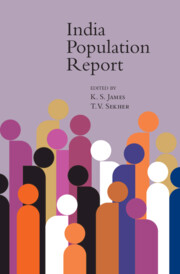3 - Fertility and Family Planning
Explaining Transition and Thinking about Post-Transitional Regimes
Published online by Cambridge University Press: 15 August 2023
Summary
Introduction
Fertility transition refers to the one-time decline in a country's fertility from an average of above five births per woman to two or below. This major demographic transformation is closely connected with socio-economic, urban, and gender-role transformations and improvements in the health and family planning of a country. Understanding fertility and family-planning dynamics of the second largest populous country occupies a unique place in the goal of global population stabilization. Historical and contemporary literature on fertility change and transition in India has largely focused on explaining determinants of fertility decline (for example, Davis, 1946; James, 1999; Drèze and Murthi, 2001; Bhat, 2002; Arokiasamy, 2002; Visaria, 2004; Kulkarni, 2011; Dharmalingam, Rajan, and Morgan, 2014; Basu and Desai, 2016; Aksan, 2021). However, at the time of completing the fertility transition (reaching the replacement level of fertility: total fertility rate [TFR] of 2.1) in the country, there is a need to revisit and understand several unique features of the family-building process in the past and present, and predict its future dynamics in the context of the second demographic transition (SDT) and sub-replacement-level fertility and help the revitalization and reformation of existing policies for the well-being of emerging unions and complex family formations.
In this chapter, we explain the dynamics and heterogeneity of fertility transition in India and its states and the key socio-economic characteristics with a special focus on the role of family planning. In addition to a discussion on fertility transition and its regional and socio-economic dynamics, the chapter makes a reflection on post-transitional fertility regimes based on lessons drawn from pre-transition and transitional regimes in India and post-transitional regimes of developed countries. The chapter takes as its starting point (a) the understanding of historical and pre-transition fertility regimes, (b) an explanation of the transitional phase and heterogamous stories from its states and key socio-economic subgroups (using an intersectionality framework, the study identifies low, lowest-low, and ultra-low fertility), (c) the role of the family-planning programme and preferences for sons in shaping India's unconventional fertility transition in the world, and (d) a speculative narrative on post-transitional regimes using a logic model. We used TFR as a measure of fertility and contraception use and its types as measures of family planning.
- Type
- Chapter
- Information
- India Population Report , pp. 46 - 109Publisher: Cambridge University PressPrint publication year: 2024



